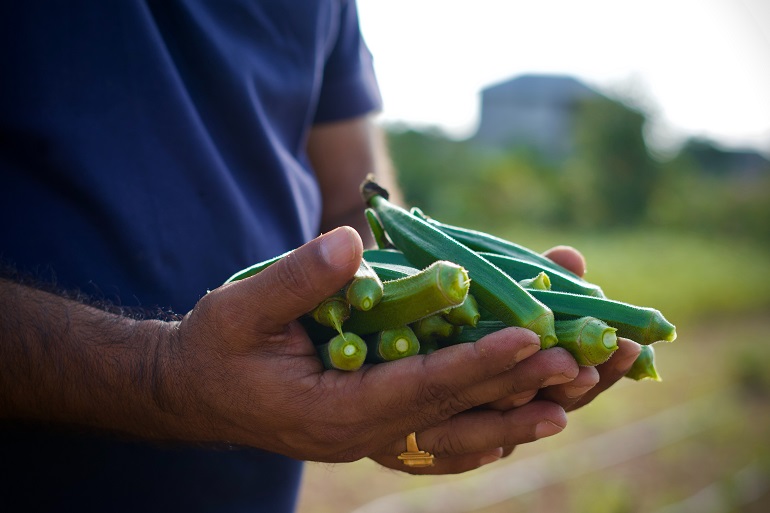Introduction
The journey of food from farm to table is a complex one, with numerous challenges along the way. One critical phase in this journey is the post-harvest period, where crops are harvested, prepared, and stored before reaching consumers. However, this phase is fraught with the potential for losses due to factors such as spoilage, pests, and improper handling. In this article, we will explore essential post-harvest handling and storage techniques that play a pivotal role in minimizing these losses, ensuring food security, and reducing waste.
The intricate journey of food from farm to table entails a multitude of challenges that must be navigated with precision and care. One pivotal phase in this journey is the post-harvest period, during which crops are harvested, prepared, and stored before they reach consumers. However, this phase is fraught with potential pitfalls that can result in significant losses, including spoilage, pest infestations, and improper handling. As we delve deeper into this concept, let’s explore the critical role of post-harvest handling and storage techniques in minimizing these losses, ensuring food security, and contributing to the broader goal of reducing food waste:
Preservation of Freshness: Post-harvest handling techniques are instrumental in preserving the freshness and quality of harvested crops. Proper cooling, sorting, and cleaning processes help maintain the visual appeal and taste of fruits, vegetables, and other perishables.
Spoilage Prevention: One of the primary challenges in the post-harvest phase is preventing spoilage. Techniques such as temperature control, humidity regulation, and the use of refrigeration or cold storage can significantly extend the shelf life of food items.
Pest and Pathogen Management: Effective post-harvest handling includes measures to manage pests and pathogens. This may involve the use of natural predators, controlled atmospheres, or safe and sustainable pesticides to protect crops without compromising food safety.
Reduction of Physical Damage: Gentle handling of harvested produce is critical to prevent physical damage, bruising, and injuries that can accelerate spoilage. Proper packing and transport methods, including cushioning and shock-absorbing materials, help mitigate such damage.
Quality Assessment: Rigorous quality assessment and sorting at the post-harvest stage ensure that only the best-quality produce reaches consumers. This reduces food waste by diverting lower-grade items to processing or secondary markets.
Efficient Storage Practices: Storage facilities equipped with adequate ventilation, temperature control, and humidity management are essential for preserving food quality. Proper organization and stacking of items also enable efficient access and rotation of inventory.
Reduced Food Losses: Minimizing food losses at the post-harvest stage is integral to global food security efforts. By preserving more of the harvested yield, we can meet the nutritional needs of growing populations while reducing the strain on natural resources.
Economic Benefits: Effective post-harvest handling techniques not only reduce food losses but also improve the economic viability of farming. Farmers can command better prices for high-quality produce, increasing their income and livelihoods.
Environmental Impact: Reduced food waste at the post-harvest stage also has positive environmental implications. It conserves resources such as water, energy, and land, and lowers greenhouse gas emissions associated with food production.
Food Security: Food security is closely tied to post-harvest management. Proper handling and storage ensure a stable and reliable food supply, particularly in regions where access to fresh produce may be limited.
Technological Innovations: Advances in technology, such as smart sensors, data analytics, and cold chain management, are revolutionizing post-harvest handling and storage practices, making them more efficient and effective.
In summary, post-harvest handling and storage techniques are integral to the preservation of food quality, the reduction of food losses, and the promotion of food security. As the world grapples with the challenge of feeding a growing population, optimizing this phase of the food journey becomes increasingly vital. By investing in innovation, infrastructure, and knowledge sharing, we can enhance these techniques and move closer to a future where food is more readily available, sustainable, and less prone to wastage.
Additionally, you can find further information on this topic by visiting this page: Small-Scale Postharvest Handling Practices
Proper handling and storage help retain the nutritional value of crops, ensuring that consumers receive the maximum health benefits from their food.
Proper handling and storage of crops serve as the guardians of nutritional value, playing a pivotal role in safeguarding the health benefits that food offers to consumers. This critical aspect of the food supply chain isn’t just about preventing spoilage; it’s about preserving the vitality of our sustenance from farm to table.
Minimizing Nutrient Loss: From the moment crops are harvested, they begin to lose some of their nutrient content. Exposure to light, heat, and oxygen, as well as improper handling and storage conditions, can accelerate this loss. Proper handling, on the other hand, involves gentle harvesting techniques and immediate post-harvest care to minimize nutrient degradation. Likewise, appropriate storage conditions, such as temperature and humidity control, ensure that these valuable nutrients remain intact.
Enhancing Shelf Life: Proper handling and storage not only retain nutritional value but also extend the shelf life of crops. This isn’t just about reducing food waste; it’s about ensuring that consumers have access to fresh and nutritious produce for longer periods. Longer shelf life means fewer instances of spoiled or unusable food, reducing the financial burden on households and food producers alike.
Safekeeping Against Contaminants: Beyond nutrient preservation, proper handling and storage are paramount for safeguarding crops against contaminants. Inadequate storage conditions can lead to mold, pests, and bacterial growth, which not only compromise the nutritional quality of food but also pose health risks to consumers. Maintaining hygiene and adopting appropriate storage techniques are essential to ensure food safety.
Economic and Environmental Impacts: Proper handling and storage practices also have far-reaching economic and environmental impacts. Efficient storage systems can help stabilize food prices by reducing post-harvest losses and fluctuations in supply. Additionally, by extending the usability of crops, we can lower the overall demand for resources and reduce the environmental footprint associated with food production.
In a world grappling with food security challenges and a growing awareness of the importance of a balanced diet, proper handling and storage represent a linchpin in the pursuit of better health outcomes for all. These practices not only ensure that consumers receive the maximum health benefits from their food but also contribute to more sustainable and efficient food systems. As we navigate the complexities of the modern food industry, remembering the fundamental role of proper handling and storage is essential to promoting nutrition, reducing waste, and fostering a healthier, more resilient society.
To delve further into this matter, we encourage you to check out the additional resources provided here: USDA’s Foreign Agricultural Service Helps Global Efforts to Reduce …

Post-harvest losses can have a significant economic impact on farmers and the food supply chain. Minimizing these losses helps maintain profitability and keeps food prices stable.
Post-harvest losses, the often silent and invisible toll on our food supply chain, carry profound economic consequences that ripple from the farm gate to consumers’ wallets. To truly appreciate the importance of minimizing these losses, it’s essential to delve deeper into how they affect both farmers and the broader food ecosystem.
1. Farmers’ Economic Well-being: For farmers, post-harvest losses translate directly into reduced income. These losses can occur due to various factors, including inadequate storage facilities, pest infestations, or transportation mishaps. In many cases, these losses represent not just wasted food but also wasted resources—seeds, water, labor, and energy—all of which contribute to a significant financial setback. By reducing post-harvest losses, farmers can safeguard their livelihoods, enhance their economic stability, and invest in the improvement of their farms, ultimately fostering a more sustainable agricultural sector.
2. Food Security and Stability: Beyond the farm, post-harvest losses reverberate throughout the food supply chain. When substantial portions of harvests are lost, the overall food supply diminishes. This can lead to fluctuations in food prices, which affect consumers directly. Unstable food prices can make it challenging for individuals and families to budget for their basic needs, particularly in regions where food costs represent a significant portion of household expenses. Reducing post-harvest losses contributes to a more stable and predictable food supply, helping mitigate price volatility.
3. Environmental Impact: Post-harvest losses not only strain economic resources but also have environmental implications. When food is wasted, all the resources used in its production, such as land, water, and energy, are squandered. Moreover, the decomposition of discarded food in landfills contributes to greenhouse gas emissions. Minimizing post-harvest losses aligns with sustainable farming practices and helps reduce the ecological footprint of food production.
4. Access to Markets: Post-harvest losses can hinder farmers’ ability to access broader markets. If produce is damaged during handling or storage, it may not meet quality standards set by retailers or distributors. This limits farmers’ opportunities to sell their goods beyond local or informal markets, where prices are often lower. Reducing losses can open up access to more lucrative markets and create opportunities for farmers to diversify their income streams.
In conclusion, addressing post-harvest losses isn’t just about preventing food from going to waste; it’s about fortifying the economic resilience of farmers, ensuring stable food prices, minimizing environmental impact, and improving access to markets. As we strive for a more sustainable and equitable food system, tackling post-harvest losses stands as a critical pillar in achieving these goals. It’s a collective responsibility that involves farmers, policymakers, and the entire supply chain working together to optimize the use of precious resources and ensure that food reaches the plates of those who need it most.
Explore this link for a more extensive examination of the topic: How to reduce postharvest crop losses in the agricultural supply chain

In a world with a growing population, reducing post-harvest losses is essential for global food security. It allows us to make the most of available resources and minimize the environmental footprint of food production.
In an era marked by a steadily expanding global population, the imperative to reduce post-harvest losses takes center stage as a linchpin for global food security. This strategic effort not only optimizes resource utilization but also aligns with broader sustainability goals, significantly curtailing the environmental footprint of our food production systems.
Maximizing Resource Efficiency: Every crop that goes to waste represents a squandered investment of resources such as water, energy, and arable land. By curbing post-harvest losses, we ensure that these precious resources are used to their fullest extent. This efficient resource allocation is essential as we strive to produce more food for a growing global population without overtaxing our natural ecosystems.
Enhancing Food Availability: Reducing post-harvest losses directly contributes to greater food availability. When a larger portion of the harvested crop reaches the market and consumers, it helps meet the dietary needs of a burgeoning world population. This is particularly crucial in regions where food scarcity is a pressing concern.
Economic Sustainability: For farmers, reducing post-harvest losses translates into improved economic viability. When more of their harvest reaches the market, they generate higher income, promoting agricultural livelihoods and rural development. It bolsters their resilience in the face of economic challenges, ultimately benefiting the entire food supply chain.
Climate and Environmental Impact: The environmental toll of food production is a significant concern, with agriculture contributing to greenhouse gas emissions, deforestation, and habitat loss. By minimizing post-harvest losses, we reduce the need to produce excess food, thereby lessening the pressure on ecosystems. This, in turn, mitigates environmental degradation and helps combat climate change.
Reduced Food Waste: Post-harvest losses are a major contributor to overall food waste. By tackling these losses, we take a significant step toward reducing the alarming levels of food waste at the consumer level. This not only conserves resources but also addresses the ethical imperative of reducing hunger and malnutrition in a world where food is discarded while millions go hungry.
Resilience to External Shocks: Reducing post-harvest losses enhances the resilience of food supply chains to external shocks, such as pandemics or extreme weather events. When the system is more efficient and less prone to disruptions, it can better weather unexpected challenges, ensuring a steady food supply even during crises.
In conclusion, the global imperative to reduce post-harvest losses transcends merely addressing inefficiencies in our food systems; it embodies a commitment to responsible resource management, economic sustainability, and environmental stewardship. As we navigate the challenges of feeding an ever-expanding world population, the journey toward minimizing post-harvest losses stands as a pivotal strategy, working in harmony with broader sustainability efforts to secure food for all while treading lightly on the planet.
Should you desire more in-depth information, it’s available for your perusal on this page: Reducing Postharvest Losses during Storage of Grain Crops to …

Timing is critical. Harvesting crops at the right stage of maturity ensures that they have the best taste, quality, and nutritional content.
Timing is indeed critical, not just in agriculture but in various aspects of life. Just as harvesting crops at the right stage of maturity ensures the best taste, quality, and nutritional content, so too does timing play a pivotal role in achieving success in many other endeavors.
In the realm of entrepreneurship, for example, launching a new product or service at precisely the right moment can make all the difference. Too early, and you might not have a receptive market; too late, and you might miss out on a competitive edge. Like a skilled farmer assessing the ripeness of crops, a savvy entrepreneur must gauge the market’s readiness for their innovation, making sure it’s primed for acceptance and adoption.
In the world of personal development, timing is equally crucial. Making life-changing decisions, such as choosing the right career path, starting a family, or pursuing higher education, requires careful consideration of one’s own readiness. Just as a farmer wouldn’t harvest crops before they’ve reached their full potential, individuals should wait until they’re adequately prepared to take on significant life commitments.
Even in the realm of interpersonal relationships, timing plays a central role. Sharing feelings, resolving conflicts, and making important commitments are all actions heavily influenced by when they occur. Expressing love or resolving disputes at the right moment can foster stronger, healthier connections, much like reaping crops at their peak ensures the best yield.
Furthermore, timing is pivotal in the digital age, where information spreads rapidly. Posting on social media, launching viral marketing campaigns, or even releasing breaking news stories all rely on a keen understanding of when the audience is most receptive. Just as a farmer must time the harvest to maximize the freshness and appeal of their produce, content creators and media outlets must publish their content when it will have the greatest impact.
In summary, the importance of timing extends far beyond the agricultural field. Whether in business, personal development, relationships, or the digital sphere, making decisions and taking actions at the right moment is often the key to achieving the best outcomes. Much like harvesting crops at the peak of maturity reaps the most rewards, seizing opportunities and making choices at the opportune time can lead to success and fulfillment in various aspects of life.
For a comprehensive look at this subject, we invite you to read more on this dedicated page: Reducing Postharvest Losses during Storage of Grain Crops to …

Gentle handling during harvesting and transportation is essential to prevent bruising or damage to crops. For delicate fruits and vegetables, using padded containers or bins can help.
Gentle handling throughout the entire journey from the field to the consumer’s table is paramount for preserving the quality and freshness of crops. Beyond the initial harvest, the way crops are transported and stored significantly impacts their appearance, taste, and nutritional value.
When it comes to delicate fruits and vegetables, an extra level of care is needed. Utilizing padded containers or bins serves as a protective barrier, reducing the risk of bruising and damage during transit. These padded containers act as a cushion, absorbing shocks and vibrations that can occur during loading, unloading, or transportation, especially on bumpy roads.
Furthermore, temperature control is equally crucial, as it helps slow down the ripening process and preserves the flavor and texture of delicate produce. Refrigerated transport or storage facilities maintain an optimal temperature range, ensuring that fruits and vegetables remain crisp and juicy when they reach their destination.
In addition to the physical condition of the crops, gentle handling also plays a role in reducing food waste. Less bruising and damage mean that a larger percentage of the harvest remains marketable, minimizing losses for both farmers and consumers.
Ultimately, recognizing the importance of gentle handling practices is a step towards promoting sustainability in agriculture and a commitment to providing consumers with the highest quality, most nutritious, and visually appealing fruits and vegetables. It also reinforces the idea that every stage of the food supply chain, from farm to table, plays a crucial role in delivering the best possible culinary experience.
Don’t stop here; you can continue your exploration by following this link for more details: Handling, Cooling and Sanitation Techniques for Maintaining …

After harvest, crops should be cleaned to remove dirt and debris. Sorting is also crucial to remove damaged or overripe items that can accelerate spoilage.
The post-harvest handling of crops is a critical phase in agriculture that can significantly impact the quality, shelf life, and marketability of agricultural products. Cleaning and sorting, two fundamental processes, play pivotal roles in ensuring that the produce reaches consumers in optimal condition while minimizing food waste.
Cleaning is the first step in the post-harvest process, and its importance cannot be overstated. After crops are harvested, they often carry dirt, soil, and various contaminants from the field. Cleaning involves removing this extraneous matter through methods such as washing, brushing, or air-blowing, depending on the type of crop. Clean crops not only have a more appealing appearance but also reduce the risk of microbial contamination, which can lead to foodborne illnesses.
Sorting, the subsequent step, is equally crucial. It involves the careful examination and categorization of harvested produce to separate items that are damaged, overripe, or otherwise unsuitable for market distribution. By identifying and removing subpar items early in the post-harvest process, sorting prevents them from accelerating spoilage and adversely affecting the quality of the entire lot.
Effective sorting also contributes to minimizing food waste, a pressing global concern. By ensuring that only high-quality, marketable produce is included in shipments, sorting helps reduce the amount of food that ends up being discarded. This is not only environmentally responsible but also economically advantageous for farmers and distributors.
In addition to enhancing food safety, appearance, and shelf life, cleaning and sorting are particularly important for certain crops that are highly perishable or sensitive to mechanical damage. Fruits and vegetables, for instance, benefit greatly from these processes to maintain their freshness and extend their marketability.
Moreover, as supply chains become increasingly globalized, maintaining high standards of cleanliness and sorting is essential to meet the strict quality and safety requirements of international markets. Many countries and regions have stringent regulations in place to ensure that imported agricultural products meet specific standards, making thorough post-harvest handling practices a prerequisite for international trade.
In conclusion, the post-harvest phases of cleaning and sorting are essential components of responsible agriculture and food supply chain management. They not only enhance the quality and safety of agricultural products but also contribute to reducing food waste and expanding market access. By recognizing the significance of these processes and implementing them effectively, the agriculture industry can continue to meet the demands of consumers for high-quality, safe, and sustainable food.
Explore this link for a more extensive examination of the topic: POST-HARVEST LOSSES AND STRATEGIES TO REDUCE THEM

Rapid cooling of fresh produce is essential to extend shelf life. Cooling reduces the metabolic rate of fruits and vegetables and helps prevent the growth of spoilage microorganisms.
“Swift and efficient cooling of fresh produce is an indispensable step in the journey from farm to table, holding the key to extending the shelf life of these nutritious treasures. The process of cooling performs a dual role: it curbs the metabolic rate of fruits and vegetables while simultaneously thwarting the advances of spoilage microorganisms, ensuring that produce reaches consumers in its prime condition.
Preserving Nutritional Value: Rapid cooling effectively puts produce into a state of suspended animation. It slows down the enzymatic reactions and respiration rates that cause fruits and vegetables to degrade over time. This preservation of metabolic activity helps retain the nutritional content, ensuring that the vitamins, minerals, and antioxidants in the produce remain intact. As a result, consumers enjoy not only extended shelf life but also the full spectrum of health benefits.
Preventing Microbial Growth: Fresh produce, by its very nature, provides an inviting environment for microorganisms seeking to flourish. Rapid cooling acts as a formidable barrier against this onslaught. It lowers the temperature of the produce to a level that discourages microbial growth, particularly that of spoilage organisms and pathogens. This intervention significantly reduces the risk of foodborne illnesses and ensures the safety of consumers.
Enhancing Flavor and Texture: Beyond nutritional benefits, cooling plays a crucial role in maintaining the flavor and texture of fruits and vegetables. It prevents the over-ripening that can lead to undesirable changes in taste and texture. Crispness is preserved, and flavors are locked in, ensuring that the produce not only lasts longer but also tastes better.
Reducing Food Waste: Rapid cooling also contributes to the reduction of food waste. By extending the shelf life of fresh produce, it reduces the likelihood of premature spoilage and the need for disposal. This is not only economically beneficial but also environmentally responsible, as it helps minimize the carbon footprint associated with food waste.
Meeting Consumer Expectations: In today’s fast-paced world, consumers expect fresh produce to look appealing and maintain its quality for longer periods. Rapid cooling aligns with these expectations, allowing retailers to provide fruits and vegetables that meet the desires of modern consumers.
Energy Efficiency: Innovative cooling technologies are increasingly focused on energy efficiency. From vacuum cooling to hydrocooling, these methods are not only effective in extending shelf life but also in minimizing energy consumption, reducing the environmental impact of the cooling process.
In conclusion, the science of rapid cooling is a behind-the-scenes hero in the realm of fresh produce. It not only extends shelf life but also preserves nutritional value, flavor, and safety while contributing to reduced food waste. This critical step in the supply chain ensures that consumers have access to high-quality fruits and vegetables, promoting both health and sustainability in our food systems.”
Should you desire more in-depth information, it’s available for your perusal on this page: HS1270/HS1270: Postharvest Storage, Packaging and Handling of …

Maintaining the right storage temperature is key to preventing spoilage. Cold storage is ideal for many fruits and vegetables, while dry storage is suitable for grains and pulses.
Maintaining the right storage temperature is indeed a fundamental principle in preserving the freshness and quality of agricultural products. It’s the first line of defense against spoilage and a crucial factor in ensuring food security and reducing food waste.
Cold storage, often synonymous with refrigeration or controlled-atmosphere storage, plays a vital role in the post-harvest life of many fruits and vegetables. This method slows down the natural ripening and decay processes by reducing the metabolic activity of the produce. By keeping the temperature low and humidity levels in check, cold storage can extend the shelf life of delicate items like berries, leafy greens, and various fruits, allowing them to remain fresh and appealing for more extended periods. This not only benefits consumers by providing access to fresh produce year-round but also benefits farmers and distributors by reducing losses due to spoilage.
Conversely, for grains and pulses, dry storage is the go-to method. These staple foods require a different approach, one that prioritizes low moisture levels to prevent the growth of molds and fungi. Properly dried and stored grains and pulses can be kept for months or even years without losing their nutritional value or becoming contaminated. This long-term storage capability is essential for food security, especially in regions where crop yields may vary due to seasonal factors or climatic conditions.
Beyond temperature considerations, maintaining proper storage conditions also involves factors like ventilation, packaging, and pest control. Adequate airflow and the use of appropriate packaging materials are crucial in preventing moisture buildup and the development of mold. Effective pest control measures, such as traps and natural repellents, are necessary to safeguard stored goods from infestations.
In essence, the science of storage is a critical component of modern agriculture and food systems. It enables us to bridge the gap between harvest and consumption, ensuring that nutritious and fresh produce is available year-round. Whether it’s the chill of cold storage or the dry embrace of grain silos, the right storage conditions are essential in the ongoing battle against food waste and in supporting food security worldwide.
To delve further into this matter, we encourage you to check out the additional resources provided here: The State of Food and Agriculture 2019

Controlling humidity levels within storage facilities is vital. High humidity can lead to mold and rot, while low humidity can cause drying and shriveling of produce.
Effective control of humidity levels within storage facilities is a critical aspect of post-harvest management that can significantly impact the quality and shelf life of agricultural produce. The nuanced management of humidity helps ensure that crops remain fresh, preserving their value and minimizing waste. Here’s an expanded perspective on the importance of humidity control:
Optimal Storage Conditions: Maintaining the right humidity levels is essential to create optimal storage conditions for different types of produce. Fruits, vegetables, and grains each have specific humidity requirements, and deviations can lead to spoilage and economic losses.
Mold and Bacterial Growth: High humidity levels create an ideal environment for mold and bacterial growth. Mold not only damages the affected produce but can also produce mycotoxins, which pose health risks if consumed. Controlling humidity helps prevent such contamination.
Reduced Post-Harvest Losses: Precise humidity control is a key strategy in reducing post-harvest losses, which can account for a significant portion of a farmer’s income. By preventing mold, rot, and spoilage, farmers can maximize the value of their harvest.
Extended Shelf Life: Controlling humidity helps extend the shelf life of produce, allowing it to remain fresh for longer periods. This is especially important when transporting goods to distant markets or when storing crops for extended periods.
Preservation of Nutritional Value: Proper humidity control minimizes the loss of nutritional value in stored crops. Excessive drying or shriveling due to low humidity can lead to a decline in the nutritional content of the produce.
Energy Efficiency: Modern storage facilities equipped with humidity control systems can optimize energy efficiency. These systems can adjust humidity levels based on the specific requirements of the stored produce, reducing energy costs and environmental impact.
Customized Solutions: Tailoring humidity control to the unique needs of different crops allows for more efficient use of storage space. This customization enables farmers to maximize storage capacity and profits.
Climate Change Resilience: With climate change leading to more frequent and severe weather events, including temperature extremes and humidity fluctuations, precise humidity control becomes increasingly important for preserving crop quality and reducing post-harvest losses.
Market Access: Complying with humidity control standards is often a requirement for accessing export markets. Meeting these standards is crucial for farmers seeking to tap into global supply chains and expand their market reach.
Food Security: Effective humidity control contributes to food security by minimizing losses in storage and distribution. It ensures that more of the harvest reaches consumers, addressing hunger and nutrition challenges.
In conclusion, the nuanced management of humidity levels in storage facilities is a linchpin in the quest for sustainable agriculture and food security. It not only preserves the economic value of crops but also plays a pivotal role in reducing food waste and post-harvest losses. As technology and best practices continue to advance, the ability to control humidity effectively becomes increasingly vital in ensuring a stable food supply for communities and markets worldwide.
For a comprehensive look at this subject, we invite you to read more on this dedicated page: The cost of inadequate postharvest management of pulse grain …

Proper ventilation helps maintain uniform temperature and humidity levels within storage spaces. It prevents the buildup of gases like ethylene, which can accelerate ripening and spoilage.
Proper ventilation in storage spaces is an indispensable aspect of preserving the quality and longevity of stored goods. Beyond its role in maintaining consistent temperature and humidity levels, ventilation serves as a guardian against a multitude of factors that can jeopardize the freshness and safety of stored items.
Mold and Mildew Prevention: Adequate ventilation inhibits the growth of mold and mildew, which thrive in damp, stagnant conditions. By ensuring a continuous flow of air, you create an environment that discourages the formation of these potentially harmful contaminants. This is particularly crucial for the storage of grains, vegetables, and other moisture-sensitive products.
Condensation Control: In spaces where temperature variations are common, condensation can pose a significant threat to stored items. Proper ventilation helps control condensation by allowing moist air to escape and drier air to circulate, reducing the risk of moisture-related damage, such as rust on metal objects or spoilage of food products.
Odor Management: Ventilation aids in dissipating odors that may emanate from stored items. In agricultural storage, for instance, certain crops emit strong odors as they ripen or deteriorate. Adequate air circulation helps disperse these odors and prevents them from permeating other stored goods, preserving their quality and taste.
Pest Deterrence: Pests such as insects and rodents are drawn to stagnant, enclosed spaces where they can easily infiltrate and infest stored items. Ventilation disrupts their preferred habitats by creating an environment that is less conducive to their survival. This is a vital aspect of maintaining food safety and quality.
Ethylene Gas Management: Ethylene, a natural plant hormone produced by fruits and vegetables, can accelerate ripening and spoilage. Adequate ventilation assists in dispersing ethylene, reducing its concentration within storage spaces. This simple measure can significantly extend the shelf life of produce and minimize food waste.
Energy Efficiency: Properly designed ventilation systems can enhance energy efficiency by helping to regulate temperature. In cold storage, for example, ventilation can help distribute heat evenly, reducing energy consumption. Conversely, in warm climates, it can aid in cooling storage spaces more efficiently.
In conclusion, ventilation in storage spaces is not merely about temperature and humidity control; it’s a multifaceted strategy for safeguarding the integrity of stored items. It mitigates the risks associated with moisture, mold, odors, pests, and ethylene gas. By investing in effective ventilation systems and practices, businesses and individuals can ensure the long-term preservation of their stored goods, minimize waste, and optimize the use of their storage facilities.
For additional details, consider exploring the related content available here Post-harvest biology and recent advances of storage technologies in …

Proper storage containers, such as airtight bags, bins, or crates, can help protect crops from pests and environmental factors. Hermetically sealed containers are particularly effective at preventing insect infestations.
Effective crop storage is not just about safeguarding the fruits of farmers’ labor; it’s a cornerstone of food security and minimizing food waste. Proper storage containers, like airtight bags, bins, or crates, play a pivotal role in preserving the quality and safety of harvested crops while extending their shelf life.
Airtight storage containers act as a protective shield against a multitude of threats. First and foremost, they create an impermeable barrier that seals crops away from pests like insects, rodents, and birds. This is especially critical in regions where insect infestations can decimate stored grains and other crops. Hermetically sealed containers, which create an oxygen-free environment, are particularly effective at thwarting insect infestations because most pests require oxygen to survive and reproduce.
Additionally, these containers provide a defense against environmental factors that can lead to spoilage. Moisture, for instance, can lead to mold growth, which not only ruins crops but can also produce mycotoxins harmful to both humans and livestock. Airtight storage helps maintain the optimal moisture content, keeping crops dry and safe.
Temperature fluctuations can also wreak havoc on stored crops, causing them to deteriorate or lose nutritional value. Proper containers can help buffer crops from extreme temperatures, maintaining a stable storage environment. This is especially crucial for perishable items like fruits and vegetables.
Furthermore, by preventing exposure to oxygen, these containers inhibit the oxidation of fats and oils within the stored crops, preserving their flavor, texture, and nutritional content. This means that when consumers eventually enjoy these crops, they are more likely to be receiving the full nutritional benefits.
Moreover, utilizing airtight storage containers is not only a boon for farmers but also a sustainable practice. By reducing post-harvest losses, we can make the most of the resources invested in agriculture, from water and energy to labor and land. In a world where food security and resource conservation are paramount concerns, effective crop storage is an essential piece of the puzzle.
In conclusion, the importance of proper storage containers in agriculture cannot be overstated. They are the unsung heroes in the battle against pests, spoilage, and food waste. Their role extends far beyond mere preservation; they are key players in ensuring that the fruits of our agricultural endeavors reach the dinner table, contributing to global food security and sustainable resource utilization.
Explore this link for a more extensive examination of the topic: HS1270/HS1270: Postharvest Storage, Packaging and Handling of …

Implementing pest control measures, such as the use of traps, natural predators, or safe pesticides, is essential to protect stored crops from insect infestations.
Effective pest control measures are an indispensable component of safeguarding stored crops from the relentless threat of insect infestations. As we delve deeper into this concept, it becomes evident that the careful implementation of pest control strategies not only ensures the preservation of harvested produce but also promotes food security, reduces economic losses, and aligns with sustainable agricultural practices:
Preservation of Quality: Protecting stored crops from insect infestations is crucial to preserving their quality. Insects can introduce molds, bacteria, and fungi, which not only compromise the appearance and taste of crops but also pose health risks.
Minimization of Food Losses: Pest control measures play a pivotal role in minimizing food losses. Without effective control, insects can decimate entire stocks of stored crops, leading to significant economic and nutritional losses.
Sustainable Practices: Embracing eco-friendly and sustainable pest control methods is paramount. The use of natural predators, such as beneficial insects or nematodes, reduces the reliance on chemical pesticides and minimizes harm to non-target species.
Integrated Pest Management (IPM): IPM strategies emphasize a holistic approach to pest control. They involve monitoring, prevention, and intervention methods that aim to reduce pest populations while minimizing the environmental impact.
Safe Pesticides: In cases where chemical pesticides are necessary, the use of safe and approved formulations is essential. These pesticides should be applied judiciously, following recommended guidelines to ensure safety for both consumers and the environment.
Resistant Pest Management: Some pests develop resistance to pesticides over time. Implementing pest control measures that consider the potential for resistance, such as rotating pesticide types or using multiple control methods, helps maintain their effectiveness.
Economic Benefits: Effective pest control directly translates to economic benefits for farmers and the agricultural industry. Reduced crop losses mean higher yields and increased revenue for farmers, contributing to economic stability in rural communities.
Food Security: Pest control measures are a linchpin in global food security efforts. By safeguarding stored crops, we ensure a stable and reliable food supply for communities, especially in regions where food scarcity is a pressing concern.
Health and Safety: Pest control measures contribute to food safety by preventing the contamination of crops with harmful substances produced by pests or pesticides. This is vital for public health and consumer confidence.
Environmental Protection: Sustainable pest control practices help protect the environment by reducing the use of chemical pesticides, which can have adverse effects on ecosystems, water quality, and non-target species.
Innovation and Research: Ongoing research and innovation in pest control methods lead to the development of more effective, safe, and environmentally friendly solutions. This continuous improvement benefits both farmers and the environment.
Global Trade: Compliance with pest control standards is essential for international trade. Implementing effective measures ensures that agricultural products meet the stringent requirements of importing countries.
In conclusion, pest control measures are an essential pillar of responsible agriculture, ensuring that the fruits of farmers’ labor are protected from the pervasive threat of insect infestations. By adopting sustainable, integrated, and safe pest management practices, we not only secure our food supply but also advance agricultural sustainability, economic prosperity, and environmental stewardship. This ongoing commitment to pest control is a testament to our dedication to feeding the world while minimizing the impact on our planet’s ecosystems.
Explore this link for a more extensive examination of the topic: Review: Food loss and waste in Sub-Saharan Africa – PMC

Conclusion
Post-harvest handling and storage techniques are integral to reducing food losses and ensuring the availability of high-quality, safe, and nutritious food for consumers. By adopting these practices, farmers, distributors, and consumers alike can contribute to food security, economic sustainability, and environmental conservation. As the global food supply chain continues to evolve, mastering these techniques remains a critical step toward a more efficient and sustainable food system.
Post-harvest handling and storage techniques stand as the unsung heroes in the journey from farm to fork, quietly but profoundly impacting our ability to feed a growing global population while respecting the planet’s limited resources. Their importance cannot be overstated, as they are integral to reducing food losses and ensuring that high-quality, safe, and nutritious food is available for consumers around the world.
Reducing Food Losses: Food losses occur at various stages of the supply chain, but post-harvest handling and storage are particularly vulnerable points. Without proper techniques, a significant portion of the harvest can go to waste due to spoilage, pests, and physical damage. By adopting best practices, we can dramatically cut these losses, preserving precious food resources and reducing the pressure to produce more to meet growing demand.
Ensuring Quality and Safety: Beyond quantity, these techniques play a pivotal role in safeguarding the quality and safety of our food. Proper storage conditions, such as temperature control and humidity regulation, help maintain the freshness and nutritional value of crops. They also protect against contamination and the growth of harmful pathogens, ensuring that the food we consume is not only nutritious but also safe.
Contributing to Food Security: Food security is not just about producing more; it’s about optimizing the use of existing resources. When post-harvest handling and storage techniques are embraced, more food reaches consumers’ plates, reducing the prevalence of hunger and malnutrition. This, in turn, contributes to the overall stability and well-being of communities and nations.
Economic Sustainability: Efficient handling and storage systems also bolster economic sustainability. Farmers can command better prices for their produce when it’s of higher quality and longer shelf life, improving their income and livelihoods. Similarly, distributors benefit from reduced losses, and consumers enjoy access to affordable, fresh, and nutritious food.
Environmental Conservation: Wasting food not only squanders valuable resources like water, energy, and land but also contributes to greenhouse gas emissions. By minimizing food losses through proper post-harvest techniques, we can significantly reduce the environmental footprint of our food systems, contributing to a more sustainable planet.
As the global food supply chain continues to evolve, mastery of these techniques remains a critical step toward a more efficient and sustainable food system. It requires collaboration among farmers, distributors, policymakers, and consumers to promote awareness and invest in the necessary infrastructure and education. Ultimately, recognizing the pivotal role of post-harvest handling and storage is not just about preserving food; it’s about preserving our future, where food security, economic prosperity, and environmental conservation intersect to create a healthier, more resilient world.
Should you desire more in-depth information, it’s available for your perusal on this page: Can gene editing reduce postharvest waste and loss of fruit …
More links
Looking for more insights? You’ll find them right here in our extended coverage: POST-HARVEST LOSSES AND STRATEGIES TO REDUCE THEM
